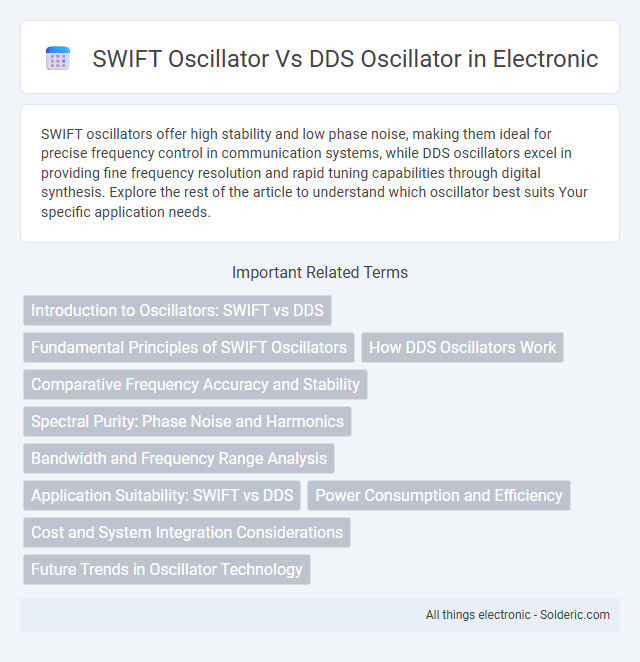SWIFT oscillators offer high stability and low phase noise, making them ideal for precise frequency control in communication systems, while DDS oscillators excel in providing fine frequency resolution and rapid tuning capabilities through digital synthesis. Explore the rest of the article to understand which oscillator best suits Your specific application needs.
Comparison Table
| Feature | SWIFT Oscillator | DDS Oscillator |
|---|---|---|
| Type | Analog Oscillator | Digital Direct Synthesis Oscillator |
| Frequency Generation | Based on analog components and feedback loops | Digitally generated frequency using phase accumulator and lookup tables |
| Tuning Range | Limited by analog components, less flexible | Wide range with fine frequency resolution |
| Frequency Stability | Susceptible to temperature and component variations | Highly stable, controlled by reference clock |
| Output Waveform | Sine wave or similar analog waveforms | Pure sine wave synthesized digitally |
| Phase Noise | Higher phase noise due to analog components | Low phase noise, depends on clock quality |
| Power Consumption | Typically lower in simple designs | Higher due to digital processing |
| Application | Simple oscillation needs, basic RF circuits | Communications, signal synthesis, modern RF systems |
Introduction to Oscillators: SWIFT vs DDS
SWIFT oscillators utilize a software-based approach to generate waveforms with high precision and flexibility, often employed in digital signal processing applications. DDS (Direct Digital Synthesis) oscillators generate stable, frequency-agile signals by numerically controlling phase increments within a digital accumulator, enabling fine frequency resolution. Both oscillators are critical in telecommunications and instrumentation, where signal purity and frequency accuracy dictate system performance.
Fundamental Principles of SWIFT Oscillators
SWIFT oscillators operate based on the principle of frequency synthesis using weighted sums of bit patterns, enabling precise and high-resolution signal generation ideal for digital communication systems. They leverage deterministic algorithms that control phase and amplitude with minimal jitter, contrasting the conventional Direct Digital Synthesis (DDS) oscillators that rely heavily on phase accumulators and lookup tables. This fundamental difference allows SWIFT oscillators to provide improved spectral purity and lower spurious emissions in complex waveform generation.
How DDS Oscillators Work
DDS oscillators generate precise and stable signals by digitally creating waveforms through phase accumulation and lookup tables, enabling fine frequency resolution and rapid frequency switching. Unlike SWIFT oscillators, which rely on analog components and phase-locked loops, DDS uses direct digital synthesis for improved accuracy and reduced phase noise. Your application benefits from DDS oscillators when requiring programmable frequencies and minimal signal distortion.
Comparative Frequency Accuracy and Stability
The SWIFT oscillator demonstrates superior frequency accuracy and long-term stability due to its advanced digital signal processing techniques, minimizing phase noise and drift over time. In contrast, the DDS (Direct Digital Synthesis) oscillator offers high frequency resolution and rapid frequency switching but can suffer from spurious signals and phase jitter impacting overall stability. While DDS excels in programmable frequency agility, SWIFT oscillators are preferred in applications demanding stringent frequency precision and minimal drift.
Spectral Purity: Phase Noise and Harmonics
SWIFT oscillators deliver superior spectral purity with significantly lower phase noise and reduced harmonic distortion compared to DDS oscillators, making them ideal for high-precision RF applications. DDS oscillators often exhibit spurious signals and quantization noise due to digital-to-analog conversion, which can degrade signal integrity and increase phase noise. Your choice of oscillator impacts system performance, especially in communication systems where clean signal generation and minimal interference are critical.
Bandwidth and Frequency Range Analysis
The SWIFT oscillator offers a wide bandwidth typically ranging from a few kilohertz to several gigahertz, providing superior frequency agility compared to traditional DDS oscillators. DDS oscillators excel in generating precise and stable frequencies within narrow bandwidths, usually up to a few hundred megahertz, due to digital synthesis limitations. Bandwidth flexibility in SWIFT oscillators enables applications requiring rapid frequency hopping and broad-spectrum coverage, while DDS oscillators prioritize frequency accuracy and phase noise performance within limited frequency ranges.
Application Suitability: SWIFT vs DDS
SWIFT oscillators excel in applications requiring rapid frequency hopping and low power consumption, making them ideal for secure communications and radar systems. DDS oscillators offer superior frequency resolution and stability, suiting applications like signal synthesis, instrumentation, and precision test equipment. Your choice depends on whether agility and power efficiency (SWIFT) or frequency accuracy and flexibility (DDS) are priorities in your system design.
Power Consumption and Efficiency
SWIFT oscillators demonstrate significantly lower power consumption compared to DDS oscillators, making them ideal for battery-powered and low-energy applications. The SWIFT design achieves high efficiency by minimizing digital processing overhead and leveraging analog components for frequency synthesis. Your choice will impact device longevity and thermal management, with SWIFT oscillators offering a more power-efficient solution.
Cost and System Integration Considerations
SWIFT oscillators typically offer lower cost benefits due to simpler architecture and fewer external components, making them ideal for budget-sensitive projects. DDS oscillators, while generally more expensive, provide superior frequency agility and integration capabilities for complex systems requiring precise frequency synthesis. Your choice depends on balancing cost constraints with the need for seamless system integration and signal performance requirements.
Future Trends in Oscillator Technology
SWIFT oscillators leverage advanced programmable delay lines providing enhanced phase noise performance and energy efficiency compared to traditional DDS oscillators, which rely on digital waveform synthesis. Future trends emphasize integrating SWIFT technology with AI-driven adaptive algorithms to enable real-time frequency tuning and improved signal integrity in 5G and beyond wireless systems. Emerging hybrid oscillator designs combining SWIFT and DDS principles aim to offer ultra-low phase noise, wide tuning range, and minimized power consumption for next-generation communication and radar platforms.
SWIFT oscillator vs DDS oscillator Infographic

 solderic.com
solderic.com